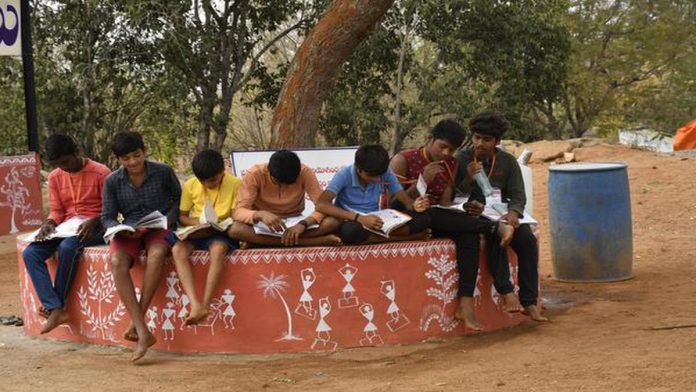Dr. Shubham Mahajan
Education inequality in rural India is a persistent problem that significantly affects the development of the country. The gap between urban and rural education systems is stark, with rural areas often suffering from a lack of resources, inadequate infrastructure, and socio-economic barriers. This article explores these challenges in detail and proposes comprehensive solutions, including the effective use of technology to bridge the gap.
Challenges Faced in Rural Education
Infrastructure and Facilities
* Classrooms and Buildings: Many rural schools operate in dilapidated buildings or even open spaces without adequate protection from the elements.
* Sanitation: Lack of proper sanitation facilities, especially toilets for girls, leads to high dropout rates among female students.
* Electricity and Water: Unreliable electricity and lack of access to clean drinking water further exacerbate the learning environment.
Quality of Education
* Teacher Shortages: Rural areas often face a severe shortage of qualified teachers, resulting in high student-teacher ratios and poor educational outcomes.
* Teaching Materials: Many schools lack basic teaching materials like textbooks, chalkboards, and laboratory equipment, which are essential for effective learning.
* Training and Development: Teachers in rural areas often have limited access to ongoing professional development, impacting the quality of education they can provide.
Socio-Economic Factors
* Poverty: Many families in rural areas live below the poverty line, making it difficult for them to afford school-related expenses.
* Caste and Gender Discrimination: Deep-rooted social norms and discrimination based on caste and gender prevent many children, especially girls and those from lower castes, from attending school.
* Child Labor: Economic necessity often forces children into labor, cutting short their education.
Digital Divide
* Internet Access: Limited or no internet connectivity in many rural areas restricts access to online educational resources.
* Technological Devices: Even when connectivity is available, the lack of access to computers and smartphones remains a significant barrier.
Strategies to Overcome
Education Inequality
Improving Infrastructure
* Government and Private Investment: Increased funding from both government and private sectors can help build and maintain better school infrastructure, including classrooms, libraries, and sanitation facilities.
* Community Involvement: Engaging local communities in school maintenance and infrastructure development can ensure sustainability and local relevance.
Enhancing Quality of Teaching
* Recruitment of Qualified Teachers: Implementing incentives such as higher salaries, housing, and hardship allowances can attract qualified teachers to rural areas.
* Continuous Professional Development: Establishing regular training programs for teachers to enhance their skills and stay updated with modern teaching methods.
Community Engagement
* Parental Involvement: Encouraging parents to participate in school activities and decision-making processes can increase their commitment to their children’s education.
* Local Governance: Forming school management committees with local leaders and community members can help address specific local issues and ensure accountability.
Equitable Resource Allocation
* Targeted Funding: Allocating resources based on need, with a focus on the most underserved areas, can help bridge the gap between rural and urban schools.
* Partnerships with NGOs: Collaborating with non-governmental organizations to provide additional resources and support to rural schools.
Promoting Inclusive Practices
* Scholarships and Financial Aid: Providing scholarships and financial assistance to students from economically disadvantaged backgrounds can help reduce dropout rates.
* Gender-Sensitive Policies: Implementing policies that specifically address the needs of girls, such as safe transportation and sanitation facilities, can promote gender equality in education.
Harnessing Technology
* Digital Classrooms: Establishing digital classrooms equipped with computers, projectors, and internet connectivity can provide rural students access to a wealth of online educational resources.
* E-Learning Platforms: Utilizing e-learning platforms like DIKSHA, an initiative by the Indian government, can offer interactive and engaging content aligned with the curriculum.
* Mobile Learning: Leveraging mobile technology to deliver educational content through apps and SMS can reach students in remote areas where internet connectivity is poor.
* Teacher Training via Technology: Online training programs and webinars for teachers can provide continuous professional development opportunities, even in remote areas.
* Community Wi-Fi: Setting up community Wi-Fi hotspots in rural villages can ensure that students and teachers have access to the internet for educational purposes.
* Solar-Powered Solutions: Implementing solar-powered digital classrooms and charging stations can overcome the challenge of unreliable electricity in rural areas.
Policy Reform and Advocacy
* Inclusive Policies: Developing and implementing policies that prioritize rural education and ensure equitable distribution of resources.
* Monitoring and Evaluation: Establishing robust monitoring and evaluation frameworks to track progress and ensure accountability in implementing education initiatives.
Conclusion
Education inequality in rural India is a multifaceted issue that requires a comprehensive and collaborative approach to address. Improving infrastructure, enhancing the quality of teaching, engaging communities, and promoting inclusive practices are critical steps towards achieving educational equity. Additionally, the strategic use of technology can significantly bridge the gap between rural and urban education systems, providing rural students with access to quality education and opportunities for a brighter future.
By addressing these challenges and implementing effective solutions, India can move closer to achieving the goal of universal access to quality education, ensuring that every child, regardless of their location or background, has the opportunity to learn, grow, and contribute to the nation’s development.


